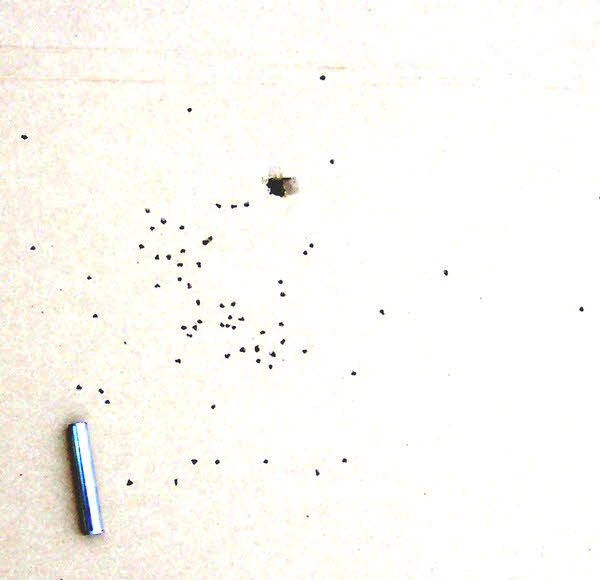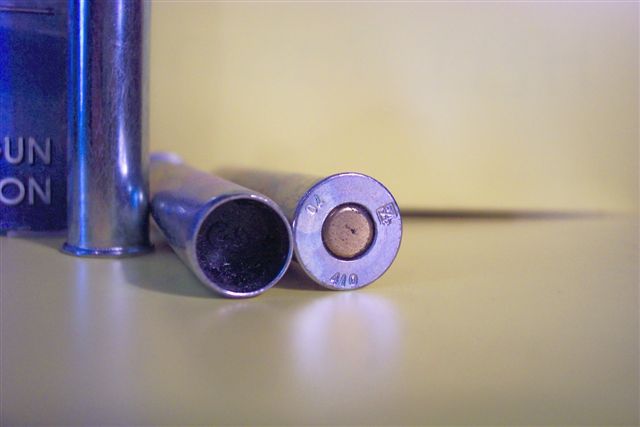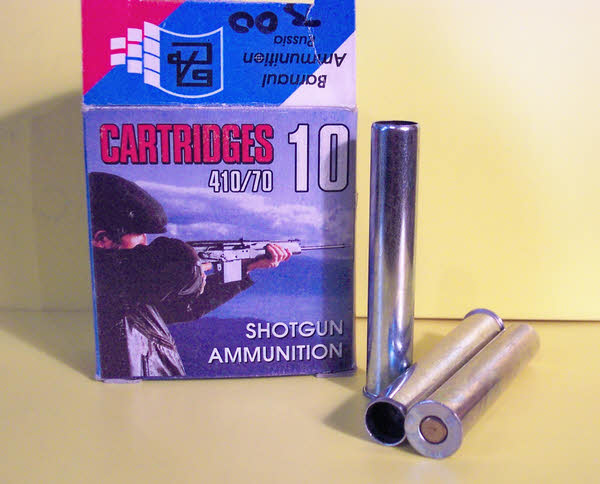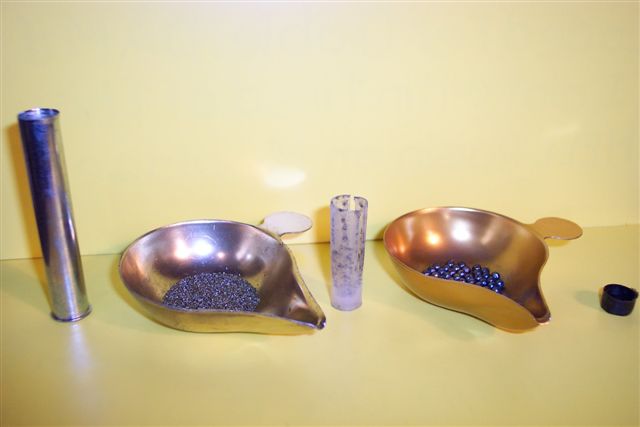 |
The Barnaul’s Steel Cased .410s.
By Marshall Williams
|
I recently acquired several little ten round boxes of Barnaul steel cased .410s. These shells are of Russian manufacture and, according to information on the box, the shells are 70 mm long and loaded with 17 grams of #3 shot.
The steel case gives the shells a handsome, if unusual appearance. To me they look a lot like a cases for a black powder buffalo rifle, one about .44 caliber and 2 3/4 inches long. I can’t help thinking the headstamp ought to say something “44-100 Ballard.”
I disassembled one of the Barnaul steel shells using an impact bullet puller to see what is inside. The first thing to come out was the plastic over shot wad. It is black, cupped on both ends, and, in fact, sits fairly deeply inside the case mouth of the loaded shell. A very effective way to seal a metal shot shell and, since it does not appear to rely on a crimp, can be used to stopper a load at any length. Next came the shot and a surprise. Both the shells that I bought, and all others I have seen, were loaded with “3" shot. My natural impulse was to suppose that the number 3 meant pellet diameter in millimeters. Wrong. The shot actually is a U.S. number 3. American number 3 shot runs about 108 to the ounce, but has not been loaded in American shotgun shells since about the time of World War Two. In fact, it has been unknown to all except disciples of the late Elmer Keith who used it in Major Askins old Ithaca 10 gauge 3 ˝ inch magnum for its superior patterns in that gun. The pellets were approximately .14 inches in diameter, the shot charge weighed 281 grains, or a tiny tad over 5/8 ounce, and contained 71 of the large pellets. When I bought the shells, I assumed that the shells were loaded with 3mm shot, roughly the size of a U.S. #6. While clearly too large for clay pigeons, I thought I might shoot a casual round of Skeet with these shells. However, #3s will carry 50% farther than 6s and penetrate skin at nearly 200 yards. So much for a casual round of Skeet. The wad looks very much like the typical one-piece plastic wads as made by Winchester, Remington, Federal, et als.
A look inside the one-piece steel case confirmed that it was loaded with a large Berdan primer. The case itself measured almost exactly 70 mm or 2 3/4 inches long. The design is similar to some older brass .410 shotgun shell cases except for being steel and, in common with the brass cases, have a slightly greater capacity than a plastic or paper case of the same length. As a rough measurement, I filled a once-fired Barnaul case with shot and then poured it out into a plastic three inch Estate-brand .410 case. The quantity of shot in the steel case was enough to slightly overflow the longer plastic case. According to information on Barnaul’s website (www.barnaulammunition.com), .410 shells of the type loaded with plastic wads are offered with shot sizes ranging from 2 mm to 4.5mm. These sizes correspond to U. S. #9 up to a U. S. BB. Shot charges may be 17 or 18 grams, roughly 5/8 ounce or 11/16 ounce of shot. Muzzle Velocity is 885.6 feet per second and chamber pressures average 12,500 pounds per square inch. Other steel-cased .410 variations are available with felt wads and with a half ounce shot charge. The website also mentions the robustness of the all steel cases and notes that some shooters report using them as many as 20 times. I see some problems for American reloaders who might want to get such case life. First, I know of no supplier for the overshot wads. Second, American reloaders avoid Berdan primed shells because their equipment is designed for the Boxer-style primers and the Berdan primers are very hard to find. If one could overcome these problems, I would expect the steel case to be relatively easy to reload. While the advertised velocity of Barnaul’s .410s seems a bit low, the shells should be entirely compatible with American .410 shotguns with three inch chambers. At this point, I have not determined exactly where in the scheme of things a .410 loaded with large goose shot is needful, however, Mick Cousins, who has experience as an Army officer in India, suggests that it might be useful for dispatching the wild dogs that surrounded every army camp. 
© Marshall Williams , 2006 |

 I do not know whether any finish treatment such as nickel plating
or pickling is used on the Barnaul shells, but the shells have a
bright finish that does not seem to tarnish easily. The case
mouth has a distinct inward roll looking vaguely like a crimp, except
that the overshot wad is well below the crimp and appears to be
held in place by friction.
I do not know whether any finish treatment such as nickel plating
or pickling is used on the Barnaul shells, but the shells have a
bright finish that does not seem to tarnish easily. The case
mouth has a distinct inward roll looking vaguely like a crimp, except
that the overshot wad is well below the crimp and appears to be
held in place by friction. The powder looked like an extruded type, but the tiny “tubes”
were smaller than Alliant 2400 or IMR 4227, and contained many small
broken grains. Powder charge was exactly 15 grains.
The powder looked like an extruded type, but the tiny “tubes”
were smaller than Alliant 2400 or IMR 4227, and contained many small
broken grains. Powder charge was exactly 15 grains.